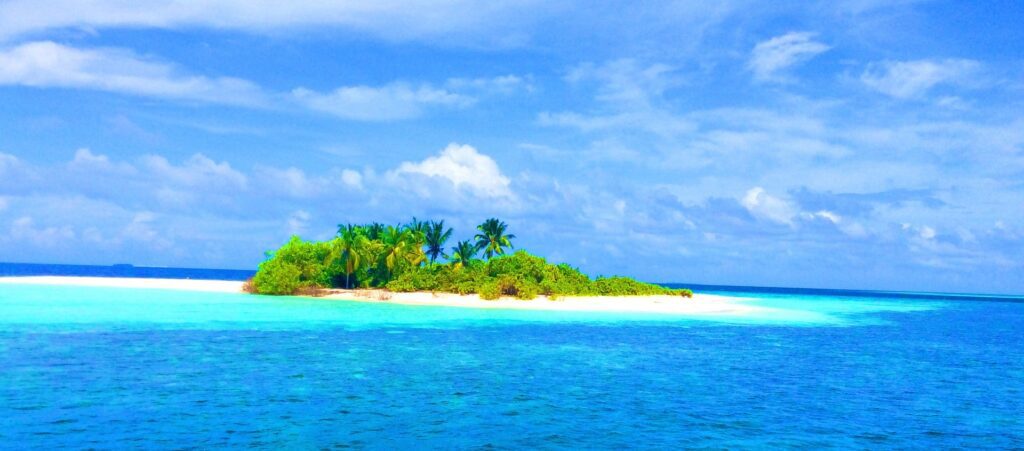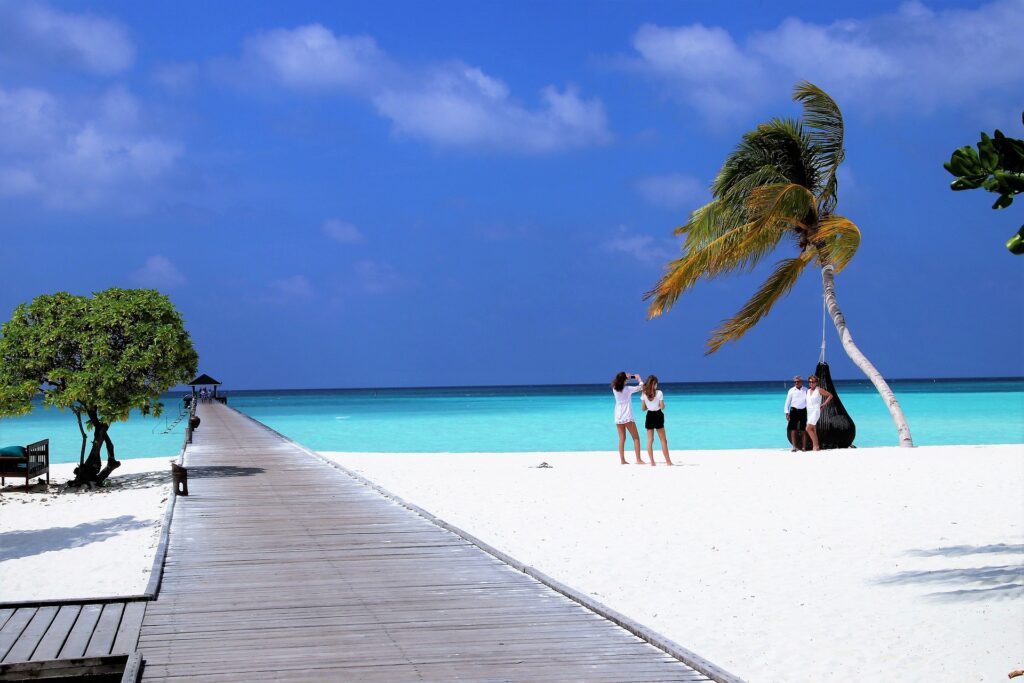

The Maldives is a tropical island nation located in the Indian Ocean, near the equator. It is composed of 26 atolls, which are made up of over 1,000 coral islands. It is known for its clear turquoise waters, coral reefs, and white sand beaches, making it a popular tourist destination for luxury beach vacations and water activities such as snorkeling and scuba diving. The country has a population of around 540,000 people and its capital city is Malé.
Visa Requirements in The Maldives
Most visitors to the Maldives require a visa to enter the country. However, there are a number of countries whose citizens are eligible for visa-free or visa-on-arrival entry, including India, China, and most countries in the European Union. For visitors who do require a visa, the process can typically be completed online or upon arrival in the Maldives. A visitor visa is valid for a stay of up to 30 days and can be extended for an additional 30 days for a fee.
It’s important to check the visa requirements before traveling to the Maldives as they can change without notice. Visitors are also advised to check the entry requirements related to the COVID-19 pandemic as it may affect visa and entry requirements.
Geography of The Maldives
The Maldives is an island nation located in the Indian Ocean, near the equator. It is the smallest Asian country by both land area and population, and one of the lowest-lying countries in the world, with an average ground level of only 1.5 meters above sea level. The country is composed of 26 atolls, which are ring-shaped coral formations that enclose lagoons. These atolls are made up of over 1,000 coral islands, with only about 200 of them being inhabited. The capital city, Malé, is located on the largest atoll, North Malé Atoll.
The islands are surrounded by clear turquoise waters and coral reefs, which provide a rich habitat for a diverse range of marine life. The coral reefs also serve as natural barriers, protecting the islands from the powerful ocean currents and waves. The climate is tropical, with high temperatures and humidity throughout the year, and two distinct monsoon seasons. The geography of the Maldives has made it vulnerable to the effects of climate change, including rising sea levels, stronger storms, and coral bleaching. The country is taking steps to address these challenges and is a leader in promoting sustainable tourism and conservation efforts to protect its unique natural resources.
Travel and Safety Requirements in The Maldives
The Maldives is generally considered to be a safe destination for travelers, with low levels of crime. However, visitors should still take standard safety precautions and be aware of their surroundings, especially in tourist areas.
- Visitors are advised to drink only bottled water and take precautions to prevent food and water-borne illnesses.
- Visitors should also take necessary precautions to protect themselves from mosquito-borne illnesses such as dengue fever and Zika virus.
- Visitors should also be respectful of local customs, traditions, and laws, including not engaging in public displays of affection.
Visitors should check with their travel agent or the Maldives Ministry of Tourism for the most up-to-date information on safety and security, as well as any entry requirements related to the COVID-19 pandemic.
Money and banks in The Maldives
The official currency which is used here is, the Maldivian rufiyaa (MVR). The currency is divided into 100 laari. Visitors to the Maldives can exchange their currency at banks, money exchanges, and some hotels. Major credit cards are widely accepted in tourist areas, but visitors should be aware that cash is still the most widely used form of payment in local areas.
Banking services in the Maldives are available in the capital city of Malé and on some of the larger resort islands. Most banks offer basic services such as cash withdrawals, money transfers, and currency exchange. There are also ATMs available in the capital and on some of the larger resort islands, but visitors should be aware that they may not always be available on smaller islands.


Food and Drinks in The Maldives
The cuisine of the Maldives is a blend of traditional Maldivian and South Indian flavors, with some influences from Sri Lanka, Africa, and Arabia. Seafood is a staple of the local diet and is often served grilled, fried, or in curries. Tuna is the most commonly consumed fish and is used in a variety of dishes. Other local dishes include roshi, a type of flatbread made from flour, water, and oil, and garudhiya, a fish soup that is a staple of the Maldivian diet. Curries made with coconut milk, chili, and spices are also popular, as are stir-fries and rice dishes.
Visitors to the Maldives will find a range of international cuisine available in tourist areas, including Italian, Indian, Chinese, and Western-style cuisine. Alcohol is generally only available in resort islands and is subject to restrictions and licensing laws. Non-alcoholic beverages include fresh juices, coconut water, and tea.
Culture of The Maldives
The culture of the Maldives is influenced by its historical and geographical location at the crossroads of the Indian Ocean. It has a mix of South Asian, African, and Arab influences. The official religion is Islam and it plays a significant role in the daily life of the Maldivians. The traditional lifestyle of the Maldivian people is centered around fishing and agriculture, although tourism is now a major source of income for the country.
Music and dance have a long history in the Maldives, with traditional performances such as Boduberu and Dhandi Jehun still being performed today. The country is also famous for its intricate lacework and mat weaving.
Family and community are highly valued in Maldivian culture and hospitality towards guests is considered a virtue. The cuisine is diverse and influenced by Indian, Sri Lankan, and Arabian cooking styles, with an emphasis on fresh seafood, coconut, and spices.
In recent years, the country has been undergoing modernization and globalization, but the traditional cultural heritage is still cherished and preserved.
Travel around The Maldives
Visitors to the Maldives can travel between the capital city of Malé and the resort islands by seaplane, speedboat, or local ferry.
Seaplanes are the quickest and most convenient option for travel between Malé and the resort islands. The flight takes around 20 minutes and offers spectacular aerial views of the islands and lagoons.
Speedboats are another option for travel between Malé and the resort islands. The journey takes around 30 minutes to 1 hour and is a more budget-friendly option than seaplanes.
Local ferries are available for travel between Malé and the outlying islands. The ferry journey takes longer than a seaplane or speedboat, but offers a unique and more affordable travel experience.
Once on a resort island, visitors can explore on foot or by bicycle. Most resorts also offer excursions and activities, such as snorkeling, diving, and island-hopping tours.
It’s important to note that the Maldives has strict laws and regulations regarding travel between the capital and the resort islands, and visitors should familiarize themselves with these regulations before traveling. Visitors should also be aware that some areas of the country, especially military facilities, may be off-limits to tourists
How to reach The Maldives
The Maldives can be reached by air, as it has its own international airport called Velana International Airport (MLE), which is the main gateway to the country. You can fly to Male, the capital of the Maldives, from major cities around the world, including cities in Asia, Europe, and the Middle East. Some airlines offer direct flights, while others may require a layover. From the airport, you can take a speedboat or a seaplane to your resort, depending on its location.
Best time to visit The Maldives
The best time to visit the Maldives is during the dry season, which ranges from November to April. During this time, the weather is sunny and warm with little rain, making it ideal for outdoor activities such as sunbathing, snorkeling, and diving. The sea is also calm, making it easier to access the many beautiful coral reefs around the islands. Keep in mind that this is also the peak tourist season, so expect higher prices and more crowded beaches.
The monsoon season, from May to October, is characterized by more rain, stronger winds, and rougher seas, but it can still be a good time to visit if you are looking for a more secluded, less crowded experience.




